HLTWHS002 Follow Safe Work Practices Assessment Workbook
VerifiedAdded on 2023/06/03
|38
|5637
|232
Homework Assignment
AI Summary
This assessment workbook, designed for the HLTWHS002 unit, focuses on safe work practices within direct client care environments. It covers essential aspects of workplace health and safety, including defining hazards, identifying and reporting WHS risks related to manual handling, infection control, and personal safety. The assessment requires students to outline control measures, report procedures, and emergency protocols. It also explores the management of client behaviors of concern, workplace policies, and procedures for safe work practices, manual handling, and personal protective equipment. Furthermore, the workbook delves into hazard identification, incident reporting, stress and fatigue management, and the importance of participating in safety meetings. The document assesses understanding of infection control, workplace debriefing, and the development of safe workplace policies and procedures.
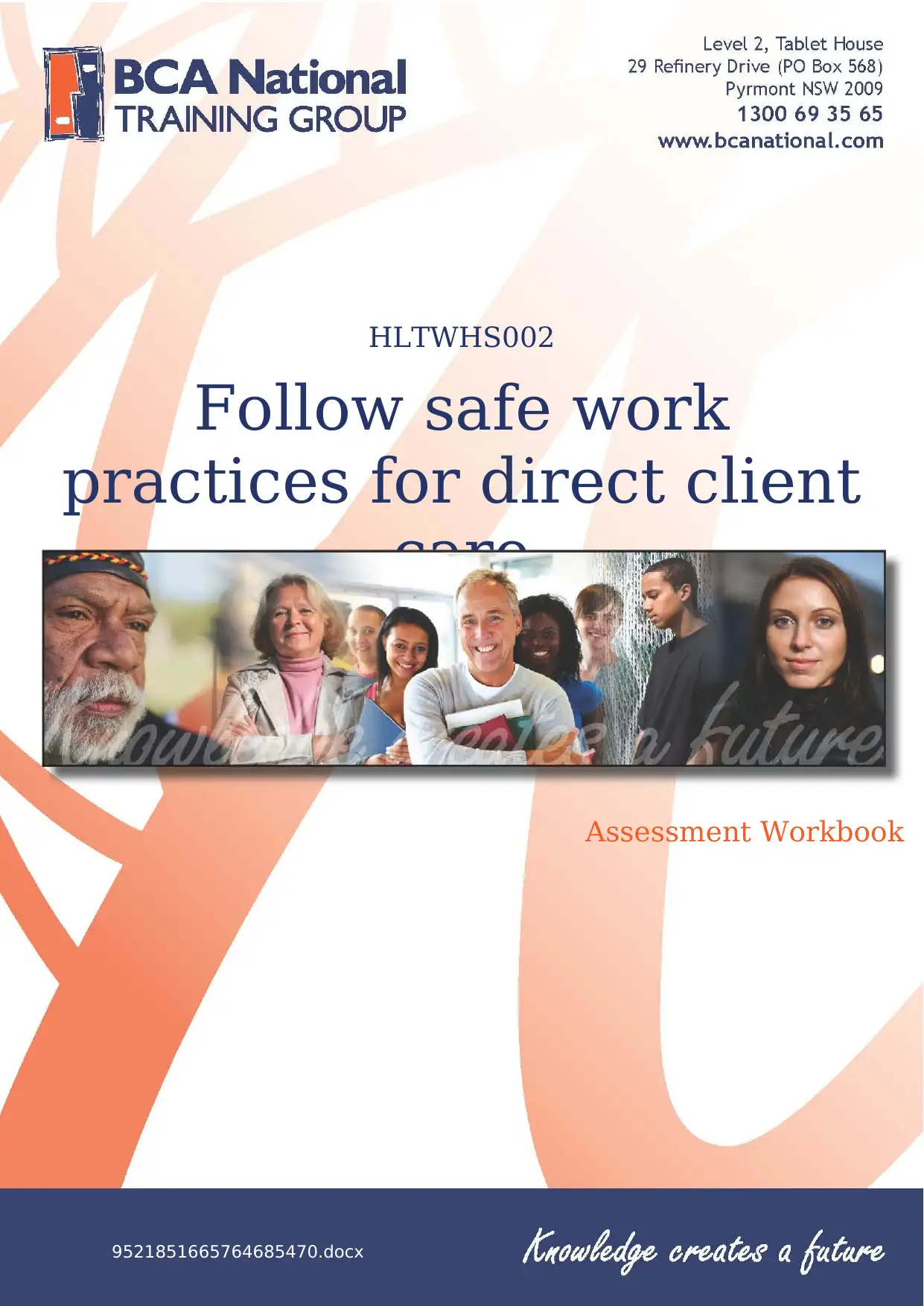
9521851665764685470.docx
HLTWHS002
Follow safe work
practices for direct client
care
Assessment Workbook
HLTWHS002
Follow safe work
practices for direct client
care
Assessment Workbook
Paraphrase This Document
Need a fresh take? Get an instant paraphrase of this document with our AI Paraphraser
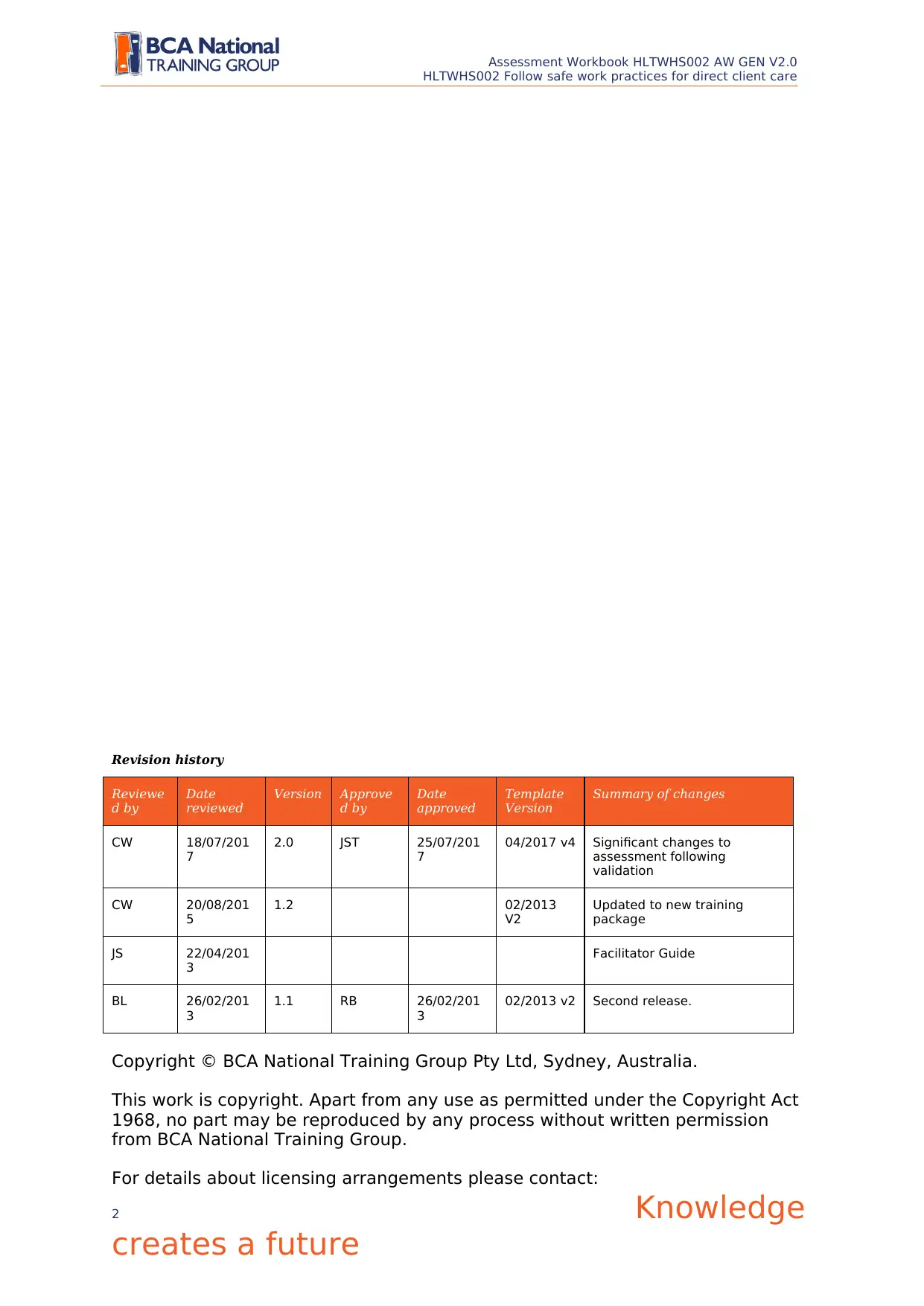
Assessment Workbook HLTWHS002 AW GEN V2.0
HLTWHS002 Follow safe work practices for direct client care
Revision history
Reviewe
d by
Date
reviewed
Version Approve
d by
Date
approved
Template
Version
Summary of changes
CW 18/07/201
7
2.0 JST 25/07/201
7
04/2017 v4 Significant changes to
assessment following
validation
CW 20/08/201
5
1.2 02/2013
V2
Updated to new training
package
JS 22/04/201
3
Facilitator Guide
BL 26/02/201
3
1.1 RB 26/02/201
3
02/2013 v2 Second release.
Copyright © BCA National Training Group Pty Ltd, Sydney, Australia.
This work is copyright. Apart from any use as permitted under the Copyright Act
1968, no part may be reproduced by any process without written permission
from BCA National Training Group.
For details about licensing arrangements please contact:
2 Knowledge
creates a future
HLTWHS002 Follow safe work practices for direct client care
Revision history
Reviewe
d by
Date
reviewed
Version Approve
d by
Date
approved
Template
Version
Summary of changes
CW 18/07/201
7
2.0 JST 25/07/201
7
04/2017 v4 Significant changes to
assessment following
validation
CW 20/08/201
5
1.2 02/2013
V2
Updated to new training
package
JS 22/04/201
3
Facilitator Guide
BL 26/02/201
3
1.1 RB 26/02/201
3
02/2013 v2 Second release.
Copyright © BCA National Training Group Pty Ltd, Sydney, Australia.
This work is copyright. Apart from any use as permitted under the Copyright Act
1968, no part may be reproduced by any process without written permission
from BCA National Training Group.
For details about licensing arrangements please contact:
2 Knowledge
creates a future
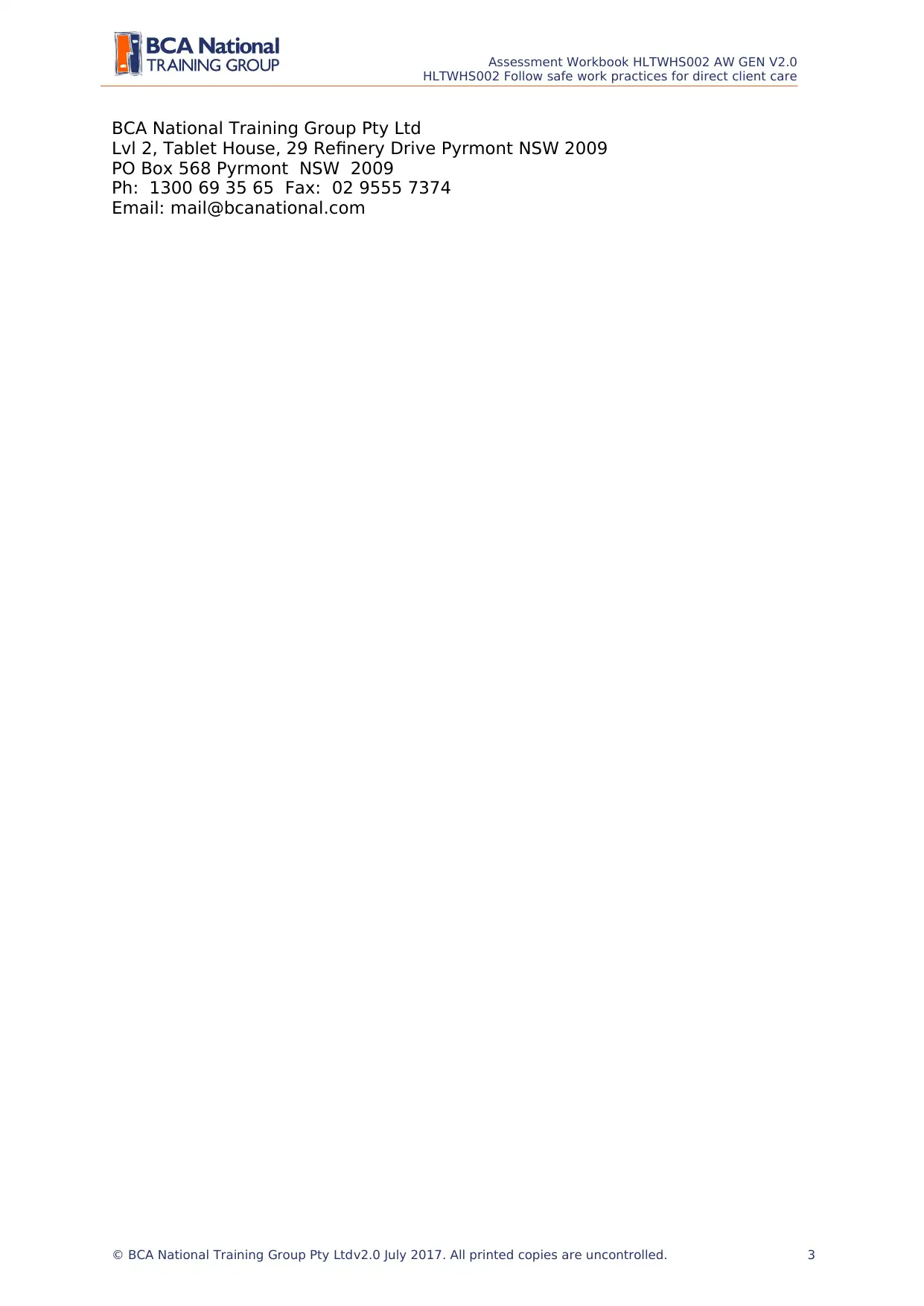
Assessment Workbook HLTWHS002 AW GEN V2.0
HLTWHS002 Follow safe work practices for direct client care
BCA National Training Group Pty Ltd
Lvl 2, Tablet House, 29 Refinery Drive Pyrmont NSW 2009
PO Box 568 Pyrmont NSW 2009
Ph: 1300 69 35 65 Fax: 02 9555 7374
Email: mail@bcanational.com
© BCA National Training Group Pty Ltdv2.0 July 2017. All printed copies are uncontrolled. 3
HLTWHS002 Follow safe work practices for direct client care
BCA National Training Group Pty Ltd
Lvl 2, Tablet House, 29 Refinery Drive Pyrmont NSW 2009
PO Box 568 Pyrmont NSW 2009
Ph: 1300 69 35 65 Fax: 02 9555 7374
Email: mail@bcanational.com
© BCA National Training Group Pty Ltdv2.0 July 2017. All printed copies are uncontrolled. 3
⊘ This is a preview!⊘
Do you want full access?
Subscribe today to unlock all pages.

Trusted by 1+ million students worldwide
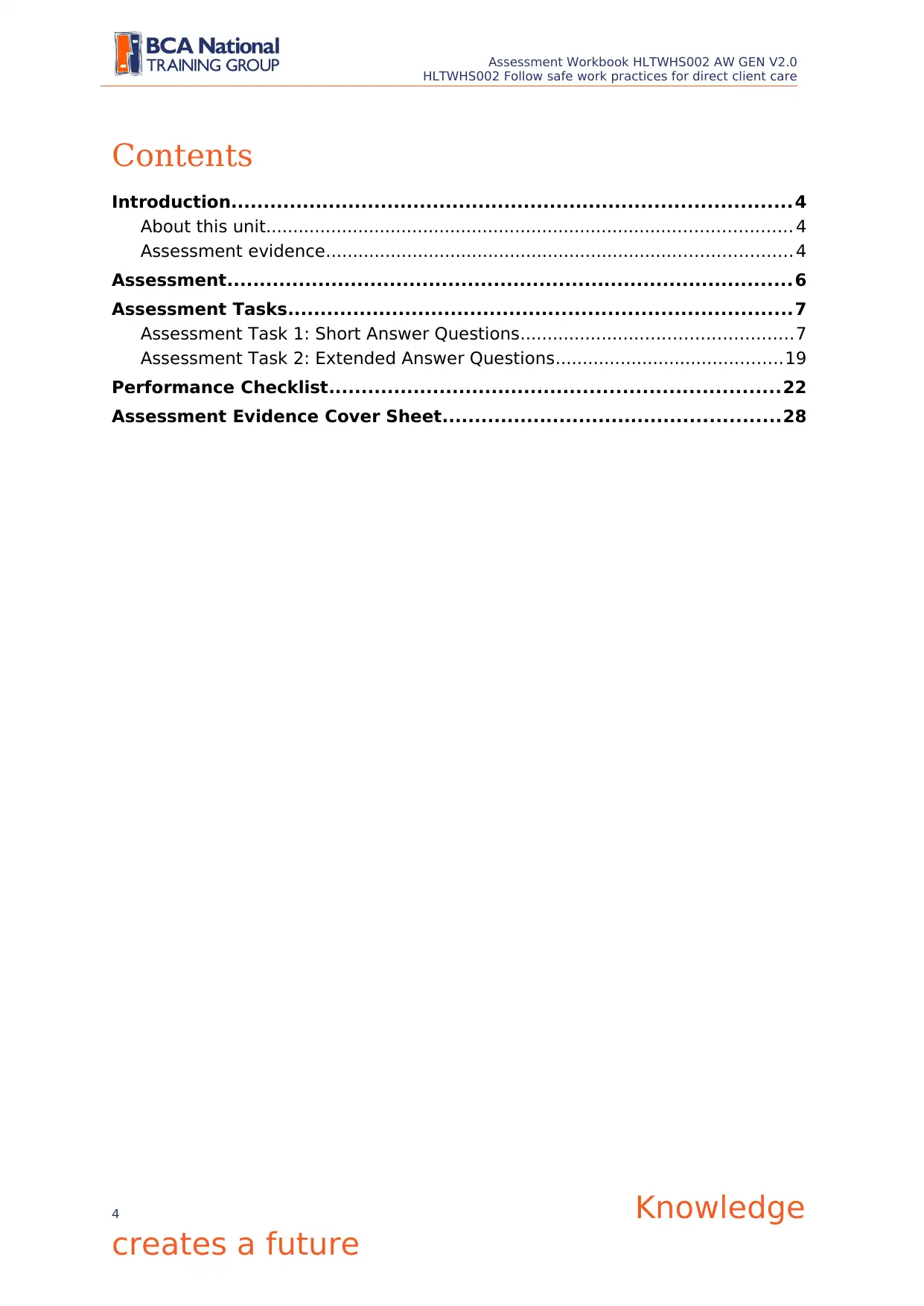
Assessment Workbook HLTWHS002 AW GEN V2.0
HLTWHS002 Follow safe work practices for direct client care
Contents
Introduction......................................................................................4
About this unit................................................................................................. 4
Assessment evidence...................................................................................... 4
Assessment.......................................................................................6
Assessment Tasks.............................................................................7
Assessment Task 1: Short Answer Questions..................................................7
Assessment Task 2: Extended Answer Questions..........................................19
Performance Checklist.....................................................................22
Assessment Evidence Cover Sheet....................................................28
4 Knowledge
creates a future
HLTWHS002 Follow safe work practices for direct client care
Contents
Introduction......................................................................................4
About this unit................................................................................................. 4
Assessment evidence...................................................................................... 4
Assessment.......................................................................................6
Assessment Tasks.............................................................................7
Assessment Task 1: Short Answer Questions..................................................7
Assessment Task 2: Extended Answer Questions..........................................19
Performance Checklist.....................................................................22
Assessment Evidence Cover Sheet....................................................28
4 Knowledge
creates a future
Paraphrase This Document
Need a fresh take? Get an instant paraphrase of this document with our AI Paraphraser
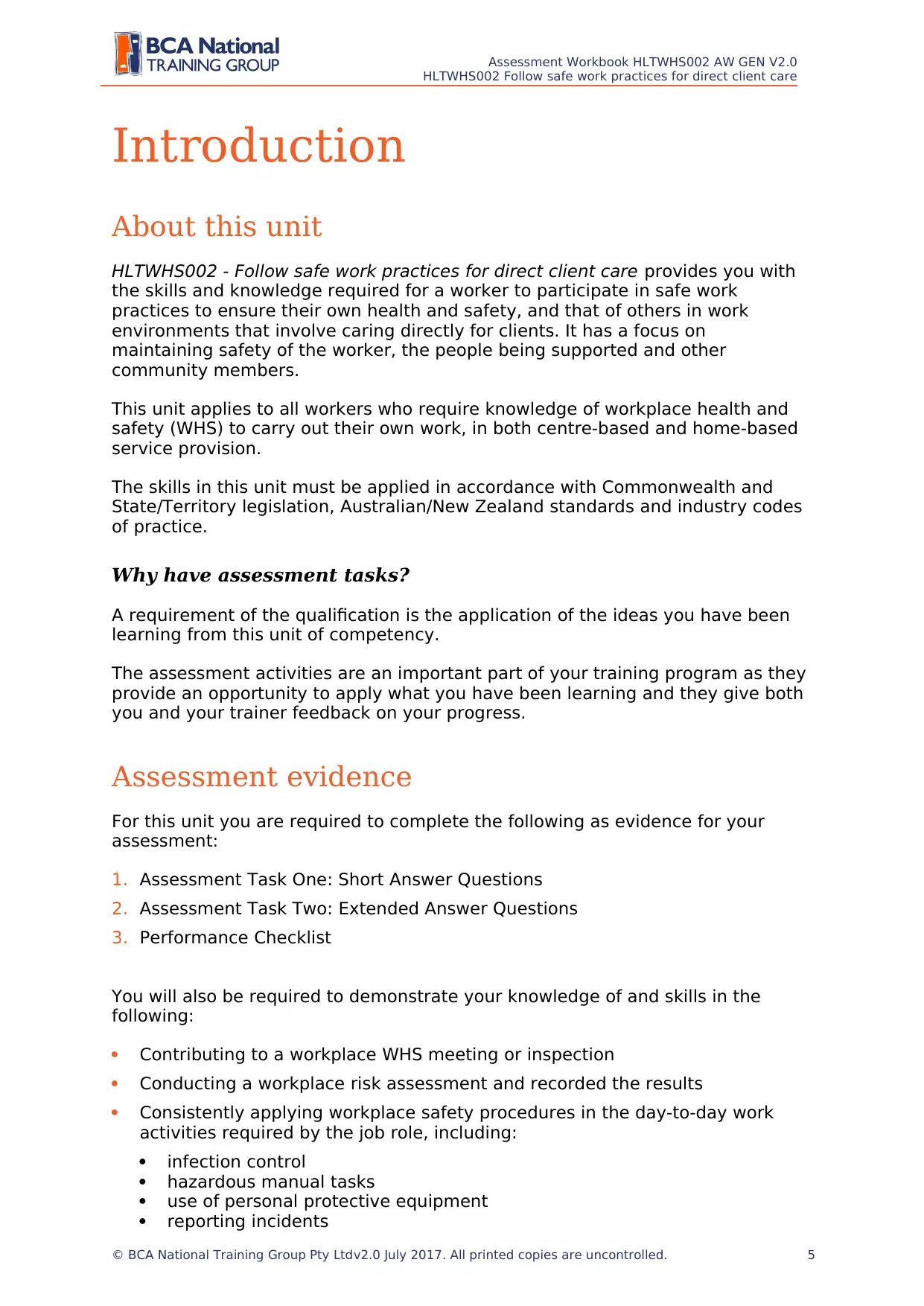
Assessment Workbook HLTWHS002 AW GEN V2.0
HLTWHS002 Follow safe work practices for direct client care
Introduction
About this unit
HLTWHS002 - Follow safe work practices for direct client care provides you with
the skills and knowledge required for a worker to participate in safe work
practices to ensure their own health and safety, and that of others in work
environments that involve caring directly for clients. It has a focus on
maintaining safety of the worker, the people being supported and other
community members.
This unit applies to all workers who require knowledge of workplace health and
safety (WHS) to carry out their own work, in both centre-based and home-based
service provision.
The skills in this unit must be applied in accordance with Commonwealth and
State/Territory legislation, Australian/New Zealand standards and industry codes
of practice.
Why have assessment tasks?
A requirement of the qualification is the application of the ideas you have been
learning from this unit of competency.
The assessment activities are an important part of your training program as they
provide an opportunity to apply what you have been learning and they give both
you and your trainer feedback on your progress.
Assessment evidence
For this unit you are required to complete the following as evidence for your
assessment:
1. Assessment Task One: Short Answer Questions
2. Assessment Task Two: Extended Answer Questions
3. Performance Checklist
You will also be required to demonstrate your knowledge of and skills in the
following:
Contributing to a workplace WHS meeting or inspection
Conducting a workplace risk assessment and recorded the results
Consistently applying workplace safety procedures in the day-to-day work
activities required by the job role, including:
infection control
hazardous manual tasks
use of personal protective equipment
reporting incidents
© BCA National Training Group Pty Ltdv2.0 July 2017. All printed copies are uncontrolled. 5
HLTWHS002 Follow safe work practices for direct client care
Introduction
About this unit
HLTWHS002 - Follow safe work practices for direct client care provides you with
the skills and knowledge required for a worker to participate in safe work
practices to ensure their own health and safety, and that of others in work
environments that involve caring directly for clients. It has a focus on
maintaining safety of the worker, the people being supported and other
community members.
This unit applies to all workers who require knowledge of workplace health and
safety (WHS) to carry out their own work, in both centre-based and home-based
service provision.
The skills in this unit must be applied in accordance with Commonwealth and
State/Territory legislation, Australian/New Zealand standards and industry codes
of practice.
Why have assessment tasks?
A requirement of the qualification is the application of the ideas you have been
learning from this unit of competency.
The assessment activities are an important part of your training program as they
provide an opportunity to apply what you have been learning and they give both
you and your trainer feedback on your progress.
Assessment evidence
For this unit you are required to complete the following as evidence for your
assessment:
1. Assessment Task One: Short Answer Questions
2. Assessment Task Two: Extended Answer Questions
3. Performance Checklist
You will also be required to demonstrate your knowledge of and skills in the
following:
Contributing to a workplace WHS meeting or inspection
Conducting a workplace risk assessment and recorded the results
Consistently applying workplace safety procedures in the day-to-day work
activities required by the job role, including:
infection control
hazardous manual tasks
use of personal protective equipment
reporting incidents
© BCA National Training Group Pty Ltdv2.0 July 2017. All printed copies are uncontrolled. 5
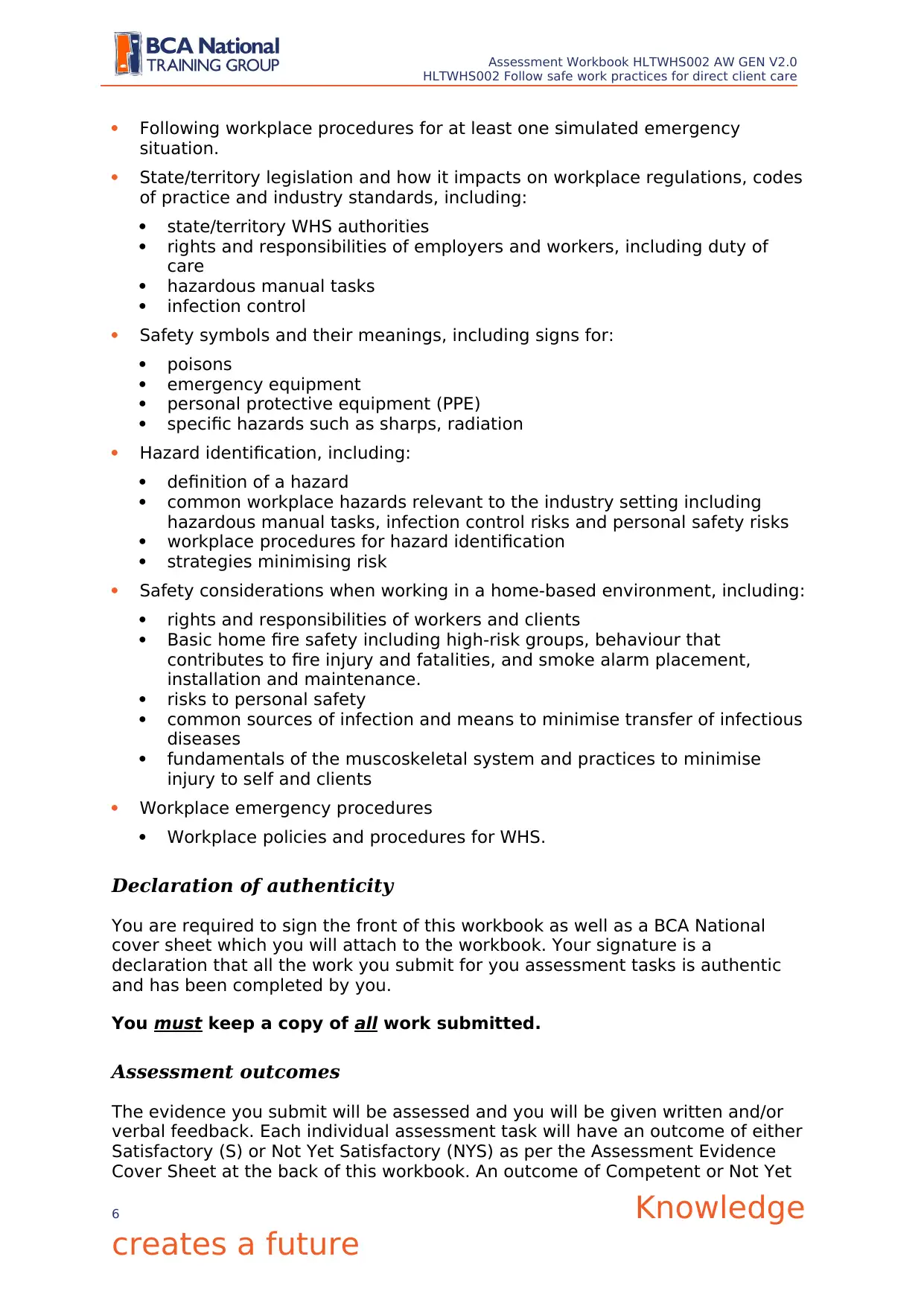
Assessment Workbook HLTWHS002 AW GEN V2.0
HLTWHS002 Follow safe work practices for direct client care
Following workplace procedures for at least one simulated emergency
situation.
State/territory legislation and how it impacts on workplace regulations, codes
of practice and industry standards, including:
state/territory WHS authorities
rights and responsibilities of employers and workers, including duty of
care
hazardous manual tasks
infection control
Safety symbols and their meanings, including signs for:
poisons
emergency equipment
personal protective equipment (PPE)
specific hazards such as sharps, radiation
Hazard identification, including:
definition of a hazard
common workplace hazards relevant to the industry setting including
hazardous manual tasks, infection control risks and personal safety risks
workplace procedures for hazard identification
strategies minimising risk
Safety considerations when working in a home-based environment, including:
rights and responsibilities of workers and clients
Basic home fire safety including high-risk groups, behaviour that
contributes to fire injury and fatalities, and smoke alarm placement,
installation and maintenance.
risks to personal safety
common sources of infection and means to minimise transfer of infectious
diseases
fundamentals of the muscoskeletal system and practices to minimise
injury to self and clients
Workplace emergency procedures
Workplace policies and procedures for WHS.
Declaration of authenticity
You are required to sign the front of this workbook as well as a BCA National
cover sheet which you will attach to the workbook. Your signature is a
declaration that all the work you submit for you assessment tasks is authentic
and has been completed by you.
You must keep a copy of all work submitted.
Assessment outcomes
The evidence you submit will be assessed and you will be given written and/or
verbal feedback. Each individual assessment task will have an outcome of either
Satisfactory (S) or Not Yet Satisfactory (NYS) as per the Assessment Evidence
Cover Sheet at the back of this workbook. An outcome of Competent or Not Yet
6 Knowledge
creates a future
HLTWHS002 Follow safe work practices for direct client care
Following workplace procedures for at least one simulated emergency
situation.
State/territory legislation and how it impacts on workplace regulations, codes
of practice and industry standards, including:
state/territory WHS authorities
rights and responsibilities of employers and workers, including duty of
care
hazardous manual tasks
infection control
Safety symbols and their meanings, including signs for:
poisons
emergency equipment
personal protective equipment (PPE)
specific hazards such as sharps, radiation
Hazard identification, including:
definition of a hazard
common workplace hazards relevant to the industry setting including
hazardous manual tasks, infection control risks and personal safety risks
workplace procedures for hazard identification
strategies minimising risk
Safety considerations when working in a home-based environment, including:
rights and responsibilities of workers and clients
Basic home fire safety including high-risk groups, behaviour that
contributes to fire injury and fatalities, and smoke alarm placement,
installation and maintenance.
risks to personal safety
common sources of infection and means to minimise transfer of infectious
diseases
fundamentals of the muscoskeletal system and practices to minimise
injury to self and clients
Workplace emergency procedures
Workplace policies and procedures for WHS.
Declaration of authenticity
You are required to sign the front of this workbook as well as a BCA National
cover sheet which you will attach to the workbook. Your signature is a
declaration that all the work you submit for you assessment tasks is authentic
and has been completed by you.
You must keep a copy of all work submitted.
Assessment outcomes
The evidence you submit will be assessed and you will be given written and/or
verbal feedback. Each individual assessment task will have an outcome of either
Satisfactory (S) or Not Yet Satisfactory (NYS) as per the Assessment Evidence
Cover Sheet at the back of this workbook. An outcome of Competent or Not Yet
6 Knowledge
creates a future
⊘ This is a preview!⊘
Do you want full access?
Subscribe today to unlock all pages.

Trusted by 1+ million students worldwide
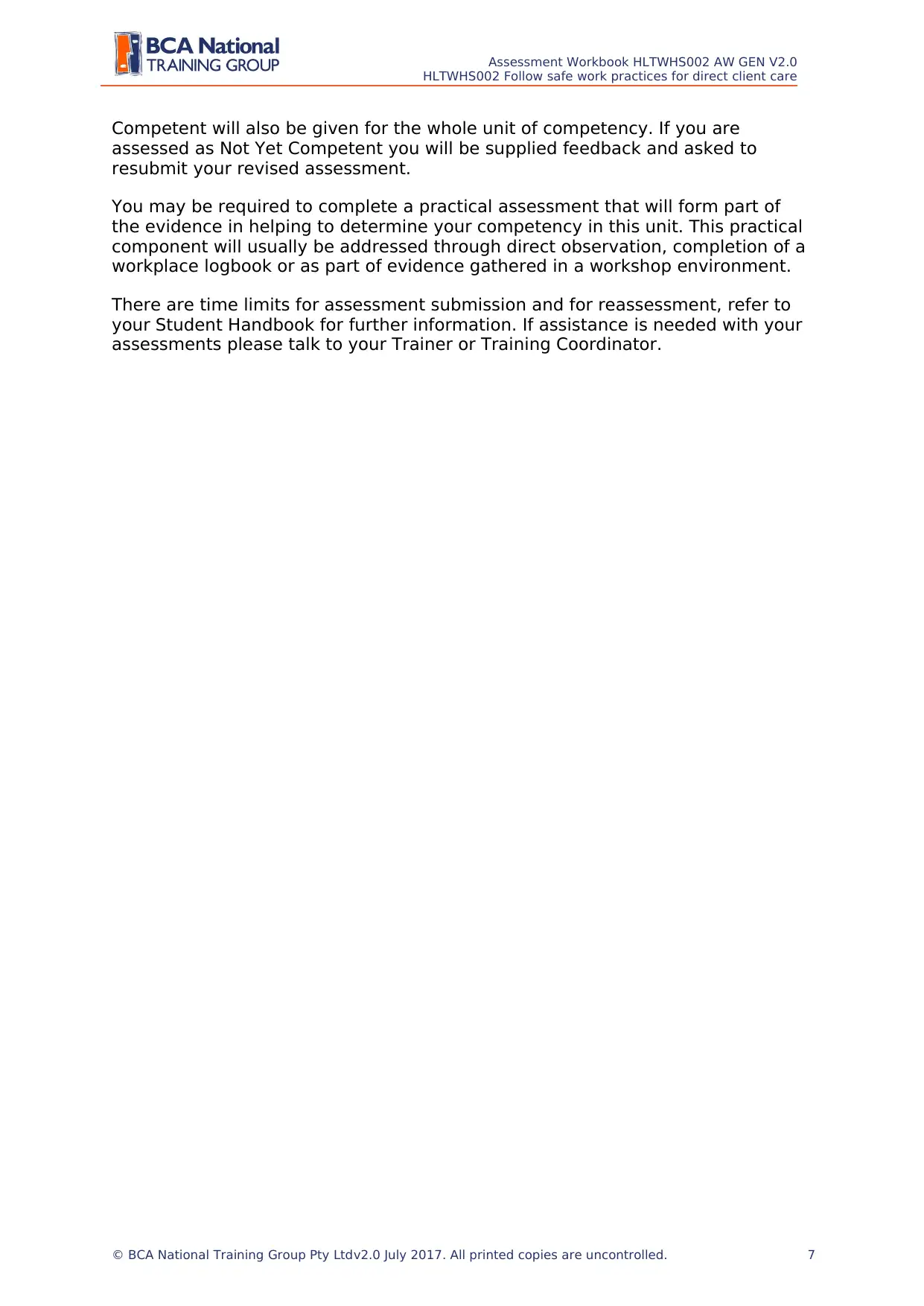
Assessment Workbook HLTWHS002 AW GEN V2.0
HLTWHS002 Follow safe work practices for direct client care
Competent will also be given for the whole unit of competency. If you are
assessed as Not Yet Competent you will be supplied feedback and asked to
resubmit your revised assessment.
You may be required to complete a practical assessment that will form part of
the evidence in helping to determine your competency in this unit. This practical
component will usually be addressed through direct observation, completion of a
workplace logbook or as part of evidence gathered in a workshop environment.
There are time limits for assessment submission and for reassessment, refer to
your Student Handbook for further information. If assistance is needed with your
assessments please talk to your Trainer or Training Coordinator.
© BCA National Training Group Pty Ltdv2.0 July 2017. All printed copies are uncontrolled. 7
HLTWHS002 Follow safe work practices for direct client care
Competent will also be given for the whole unit of competency. If you are
assessed as Not Yet Competent you will be supplied feedback and asked to
resubmit your revised assessment.
You may be required to complete a practical assessment that will form part of
the evidence in helping to determine your competency in this unit. This practical
component will usually be addressed through direct observation, completion of a
workplace logbook or as part of evidence gathered in a workshop environment.
There are time limits for assessment submission and for reassessment, refer to
your Student Handbook for further information. If assistance is needed with your
assessments please talk to your Trainer or Training Coordinator.
© BCA National Training Group Pty Ltdv2.0 July 2017. All printed copies are uncontrolled. 7
Paraphrase This Document
Need a fresh take? Get an instant paraphrase of this document with our AI Paraphraser
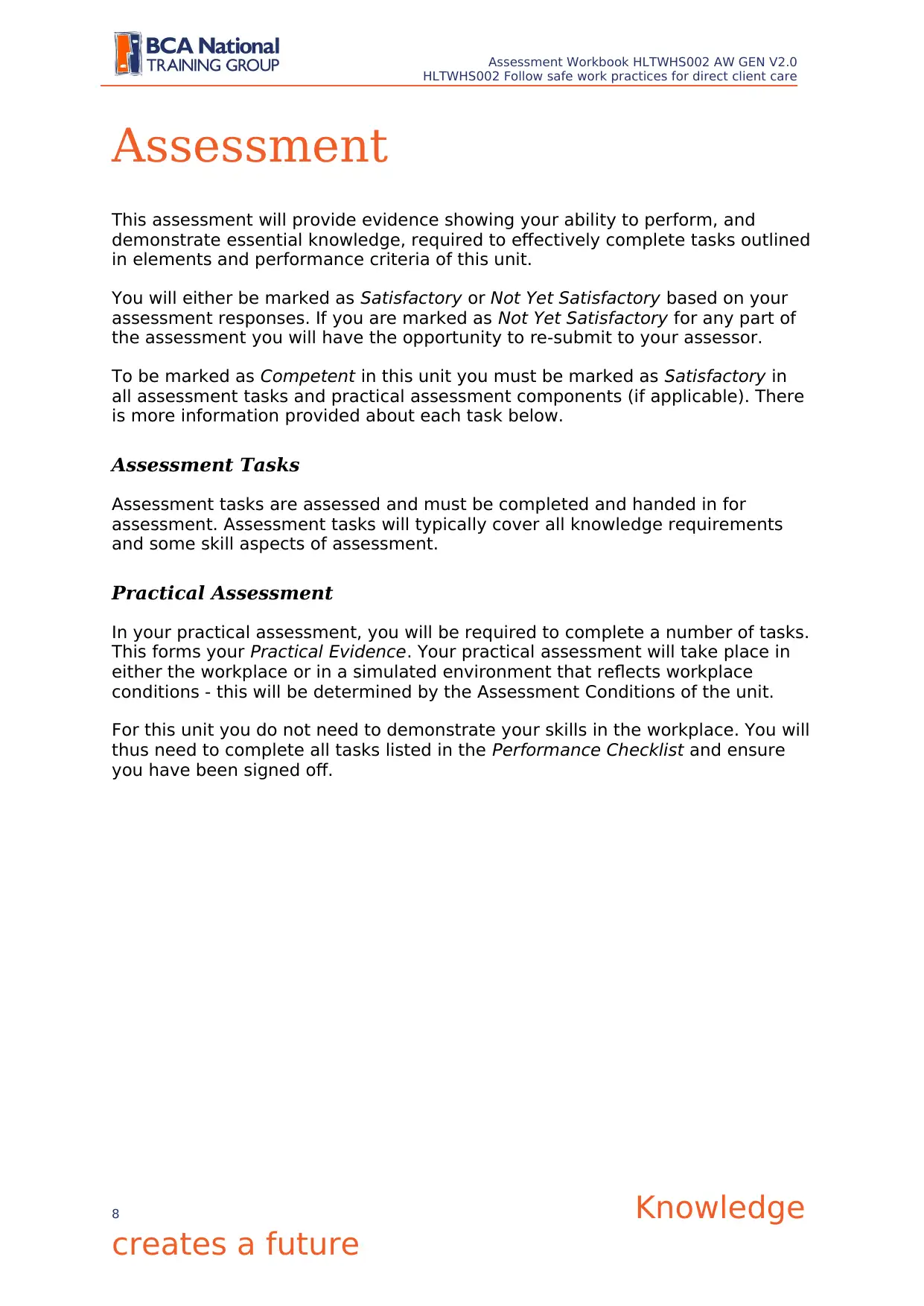
Assessment Workbook HLTWHS002 AW GEN V2.0
HLTWHS002 Follow safe work practices for direct client care
Assessment
This assessment will provide evidence showing your ability to perform, and
demonstrate essential knowledge, required to effectively complete tasks outlined
in elements and performance criteria of this unit.
You will either be marked as Satisfactory or Not Yet Satisfactory based on your
assessment responses. If you are marked as Not Yet Satisfactory for any part of
the assessment you will have the opportunity to re-submit to your assessor.
To be marked as Competent in this unit you must be marked as Satisfactory in
all assessment tasks and practical assessment components (if applicable). There
is more information provided about each task below.
Assessment Tasks
Assessment tasks are assessed and must be completed and handed in for
assessment. Assessment tasks will typically cover all knowledge requirements
and some skill aspects of assessment.
Practical Assessment
In your practical assessment, you will be required to complete a number of tasks.
This forms your Practical Evidence. Your practical assessment will take place in
either the workplace or in a simulated environment that reflects workplace
conditions - this will be determined by the Assessment Conditions of the unit.
For this unit you do not need to demonstrate your skills in the workplace. You will
thus need to complete all tasks listed in the Performance Checklist and ensure
you have been signed off.
8 Knowledge
creates a future
HLTWHS002 Follow safe work practices for direct client care
Assessment
This assessment will provide evidence showing your ability to perform, and
demonstrate essential knowledge, required to effectively complete tasks outlined
in elements and performance criteria of this unit.
You will either be marked as Satisfactory or Not Yet Satisfactory based on your
assessment responses. If you are marked as Not Yet Satisfactory for any part of
the assessment you will have the opportunity to re-submit to your assessor.
To be marked as Competent in this unit you must be marked as Satisfactory in
all assessment tasks and practical assessment components (if applicable). There
is more information provided about each task below.
Assessment Tasks
Assessment tasks are assessed and must be completed and handed in for
assessment. Assessment tasks will typically cover all knowledge requirements
and some skill aspects of assessment.
Practical Assessment
In your practical assessment, you will be required to complete a number of tasks.
This forms your Practical Evidence. Your practical assessment will take place in
either the workplace or in a simulated environment that reflects workplace
conditions - this will be determined by the Assessment Conditions of the unit.
For this unit you do not need to demonstrate your skills in the workplace. You will
thus need to complete all tasks listed in the Performance Checklist and ensure
you have been signed off.
8 Knowledge
creates a future
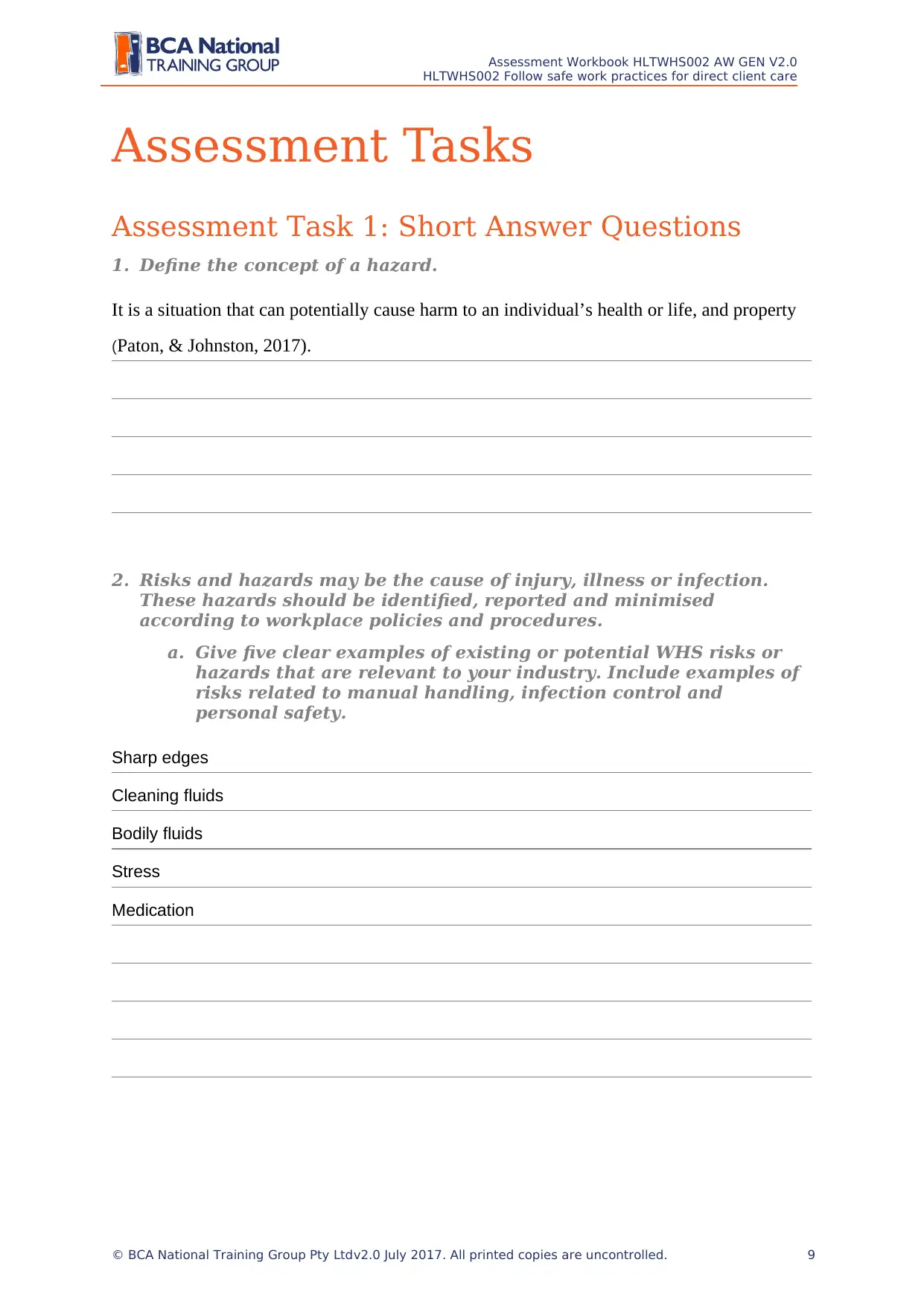
Assessment Workbook HLTWHS002 AW GEN V2.0
HLTWHS002 Follow safe work practices for direct client care
Assessment Tasks
Assessment Task 1: Short Answer Questions
1. Define the concept of a hazard.
It is a situation that can potentially cause harm to an individual’s health or life, and property
(Paton, & Johnston, 2017).
2. Risks and hazards may be the cause of injury, illness or infection.
These hazards should be identified, reported and minimised
according to workplace policies and procedures.
a. Give five clear examples of existing or potential WHS risks or
hazards that are relevant to your industry. Include examples of
risks related to manual handling, infection control and
personal safety.
Sharp edges
Cleaning fluids
Bodily fluids
Stress
Medication
© BCA National Training Group Pty Ltdv2.0 July 2017. All printed copies are uncontrolled. 9
HLTWHS002 Follow safe work practices for direct client care
Assessment Tasks
Assessment Task 1: Short Answer Questions
1. Define the concept of a hazard.
It is a situation that can potentially cause harm to an individual’s health or life, and property
(Paton, & Johnston, 2017).
2. Risks and hazards may be the cause of injury, illness or infection.
These hazards should be identified, reported and minimised
according to workplace policies and procedures.
a. Give five clear examples of existing or potential WHS risks or
hazards that are relevant to your industry. Include examples of
risks related to manual handling, infection control and
personal safety.
Sharp edges
Cleaning fluids
Bodily fluids
Stress
Medication
© BCA National Training Group Pty Ltdv2.0 July 2017. All printed copies are uncontrolled. 9
⊘ This is a preview!⊘
Do you want full access?
Subscribe today to unlock all pages.

Trusted by 1+ million students worldwide
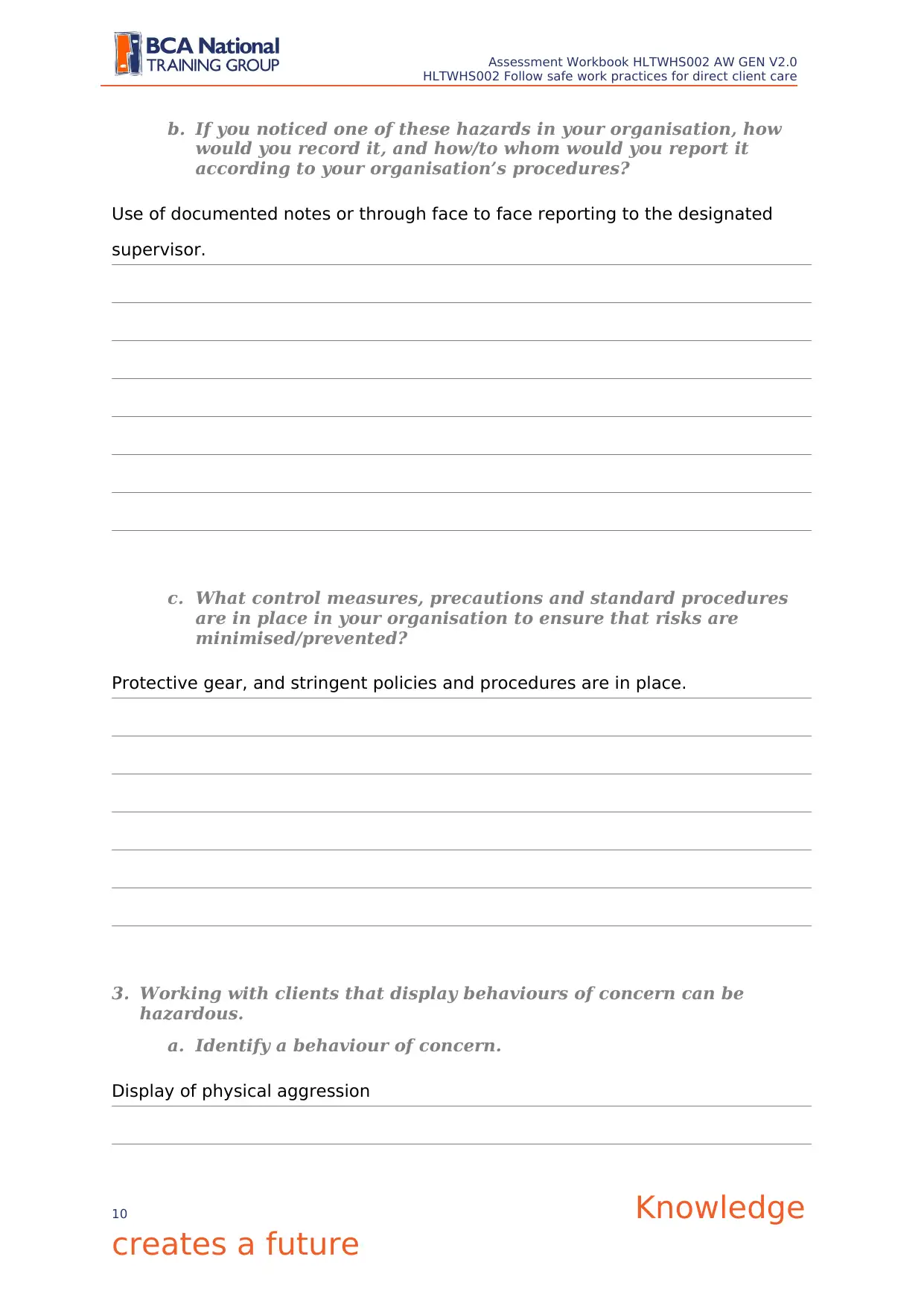
Assessment Workbook HLTWHS002 AW GEN V2.0
HLTWHS002 Follow safe work practices for direct client care
b. If you noticed one of these hazards in your organisation, how
would you record it, and how/to whom would you report it
according to your organisation’s procedures?
Use of documented notes or through face to face reporting to the designated
supervisor.
c. What control measures, precautions and standard procedures
are in place in your organisation to ensure that risks are
minimised/prevented?
Protective gear, and stringent policies and procedures are in place.
3. Working with clients that display behaviours of concern can be
hazardous.
a. Identify a behaviour of concern.
Display of physical aggression
10 Knowledge
creates a future
HLTWHS002 Follow safe work practices for direct client care
b. If you noticed one of these hazards in your organisation, how
would you record it, and how/to whom would you report it
according to your organisation’s procedures?
Use of documented notes or through face to face reporting to the designated
supervisor.
c. What control measures, precautions and standard procedures
are in place in your organisation to ensure that risks are
minimised/prevented?
Protective gear, and stringent policies and procedures are in place.
3. Working with clients that display behaviours of concern can be
hazardous.
a. Identify a behaviour of concern.
Display of physical aggression
10 Knowledge
creates a future
Paraphrase This Document
Need a fresh take? Get an instant paraphrase of this document with our AI Paraphraser
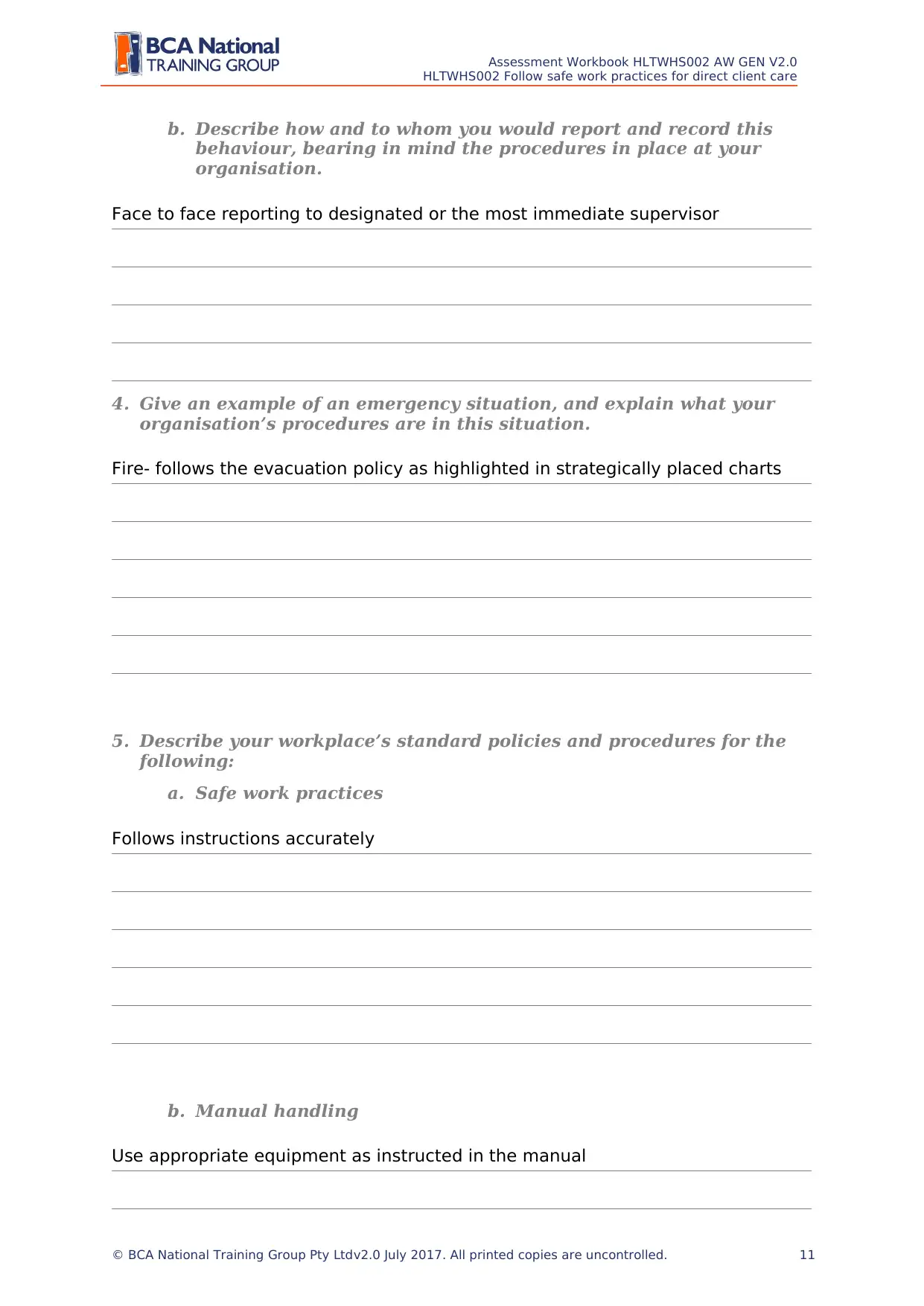
Assessment Workbook HLTWHS002 AW GEN V2.0
HLTWHS002 Follow safe work practices for direct client care
b. Describe how and to whom you would report and record this
behaviour, bearing in mind the procedures in place at your
organisation.
Face to face reporting to designated or the most immediate supervisor
4. Give an example of an emergency situation, and explain what your
organisation’s procedures are in this situation.
Fire- follows the evacuation policy as highlighted in strategically placed charts
5. Describe your workplace’s standard policies and procedures for the
following:
a. Safe work practices
Follows instructions accurately
b. Manual handling
Use appropriate equipment as instructed in the manual
© BCA National Training Group Pty Ltdv2.0 July 2017. All printed copies are uncontrolled. 11
HLTWHS002 Follow safe work practices for direct client care
b. Describe how and to whom you would report and record this
behaviour, bearing in mind the procedures in place at your
organisation.
Face to face reporting to designated or the most immediate supervisor
4. Give an example of an emergency situation, and explain what your
organisation’s procedures are in this situation.
Fire- follows the evacuation policy as highlighted in strategically placed charts
5. Describe your workplace’s standard policies and procedures for the
following:
a. Safe work practices
Follows instructions accurately
b. Manual handling
Use appropriate equipment as instructed in the manual
© BCA National Training Group Pty Ltdv2.0 July 2017. All printed copies are uncontrolled. 11
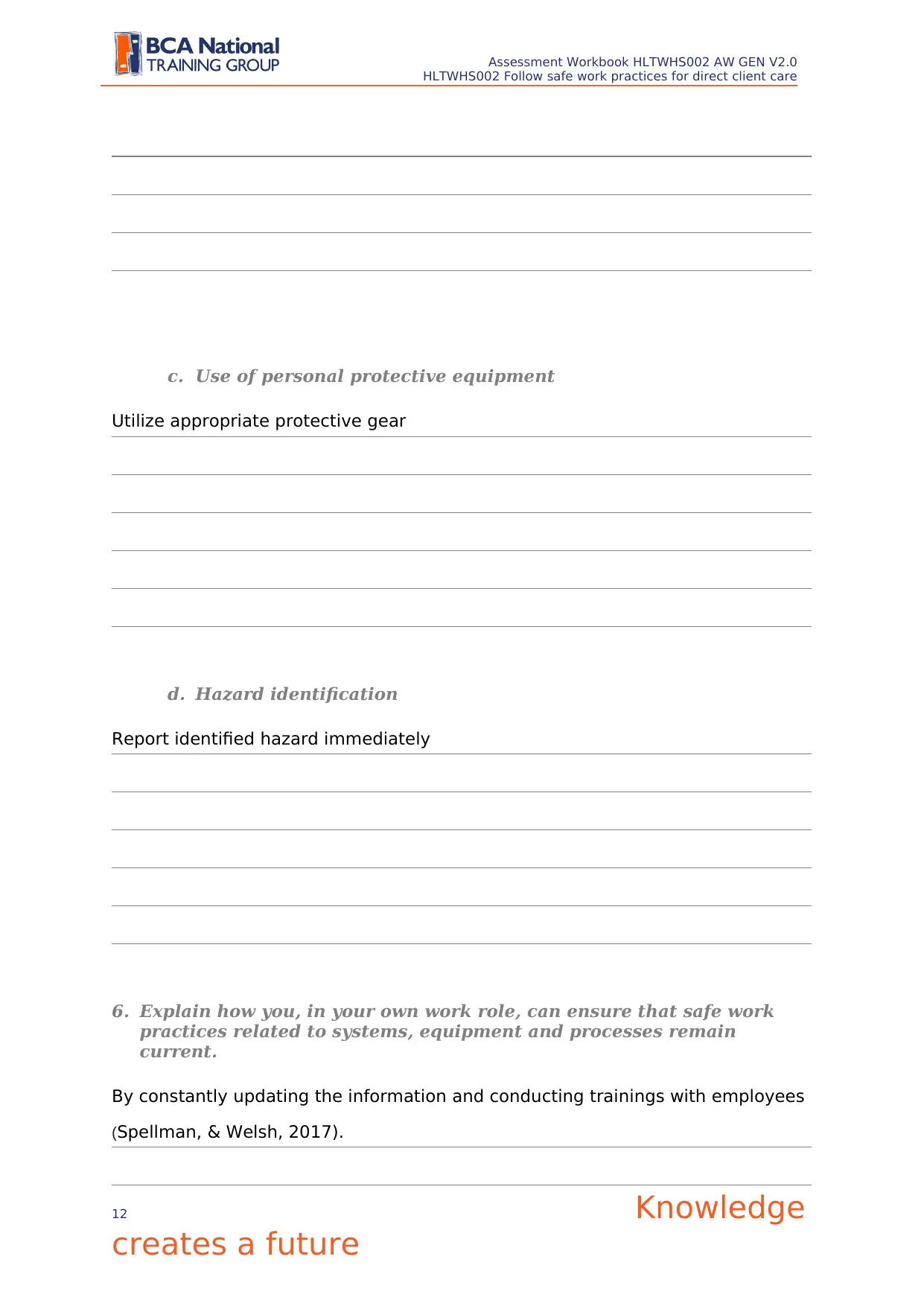
Assessment Workbook HLTWHS002 AW GEN V2.0
HLTWHS002 Follow safe work practices for direct client care
c. Use of personal protective equipment
Utilize appropriate protective gear
d. Hazard identification
Report identified hazard immediately
6. Explain how you, in your own work role, can ensure that safe work
practices related to systems, equipment and processes remain
current.
By constantly updating the information and conducting trainings with employees
(Spellman, & Welsh, 2017).
12 Knowledge
creates a future
HLTWHS002 Follow safe work practices for direct client care
c. Use of personal protective equipment
Utilize appropriate protective gear
d. Hazard identification
Report identified hazard immediately
6. Explain how you, in your own work role, can ensure that safe work
practices related to systems, equipment and processes remain
current.
By constantly updating the information and conducting trainings with employees
(Spellman, & Welsh, 2017).
12 Knowledge
creates a future
⊘ This is a preview!⊘
Do you want full access?
Subscribe today to unlock all pages.

Trusted by 1+ million students worldwide
1 out of 38
Related Documents
Your All-in-One AI-Powered Toolkit for Academic Success.
+13062052269
info@desklib.com
Available 24*7 on WhatsApp / Email
![[object Object]](/_next/static/media/star-bottom.7253800d.svg)
Unlock your academic potential
Copyright © 2020–2025 A2Z Services. All Rights Reserved. Developed and managed by ZUCOL.





